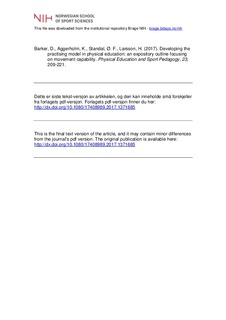| dc.contributor.author | Barker, Dean | |
| dc.contributor.author | Aggerholm, Kenneth | |
| dc.contributor.author | Standal, Øyvind Førland | |
| dc.contributor.author | Larsson, Håkan | |
| dc.date.accessioned | 2018-09-13T07:52:20Z | |
| dc.date.available | 2018-09-13T07:52:20Z | |
| dc.date.created | 2017-10-03T22:14:51Z | |
| dc.date.issued | 2017 | |
| dc.identifier.citation | Physical Education and Sport Pedagogy. 2018, 23, 209-221. | nb_NO |
| dc.identifier.issn | 1740-8989 | |
| dc.identifier.uri | http://hdl.handle.net/11250/2562348 | |
| dc.description | I Brage finner du siste tekst-versjon av artikkelen, og den kan inneholde ubetydelige forskjeller fra forlagets pdf-versjon. Forlagets pdf-versjon finner du på tandfonline.com / In Brage you'll fin the final text-version of the article, and it may contain insignificant differences from the journal's pdf-version. The definitive version is available at tandfonline.com | nb_NO |
| dc.description.abstract | Background: Physical educators currently have a number of pedagogical (or curricular) models at their disposal. While existing models have been well-received in educational contexts, these models seek to extend students’ capacities within a limited number of ‘human activities’ (Arendt, 1958). The activity of human practising, which is concerned with the improvement of the self, is not explicitly dealt with by current models. Purpose: The aim of the paper is to outline how a model of human practising related to movement capability could be enacted in physical education. Findings: Building on a theoretical exposition of human practising presented in a separate paper, this paper provides a practically oriented discussion related to: (1) the general learning outcomes as well as teaching and learning strategies of the model; (2) an outline of five activities that describe how the model could be implemented; and (3) the non-negotiable features of the model. Discussion: The model’s potential contribution to the ongoing revitalization of PE as an institutionalized educational practice is discussed. Points concerning how the model relates to wider physical cultures, its position regarding transfer of learning, standards of excellence, and social and cultural transmission are considered. Conclusion: The paper is concluded with some reflections on pedagogical models generally and how they relate to the pedagogical model of practising movement capability presented in this paper. | nb_NO |
| dc.language.iso | eng | nb_NO |
| dc.subject | practising | nb_NO |
| dc.subject | movement | nb_NO |
| dc.subject | models | nb_NO |
| dc.subject | skill | nb_NO |
| dc.subject | development | nb_NO |
| dc.subject | practical knowledge | nb_NO |
| dc.title | Developing the practising model in physical education: an expository outline focusing on movement capability | nb_NO |
| dc.type | Journal article | nb_NO |
| dc.type | Peer reviewed | nb_NO |
| dc.description.version | acceptedVersion | nb_NO |
| dc.source.pagenumber | 13 | nb_NO |
| dc.source.journal | Physical Education and Sport Pedagogy | nb_NO |
| dc.identifier.doi | 10.1080/17408989.2017.1371685 | |
| dc.identifier.cristin | 1502020 | |
| dc.description.localcode | Seksjon for kroppsøving og pedagogikk / Department of Physical Education | nb_NO |
| cristin.unitcode | 150,35,0,0 | |
| cristin.unitname | Seksjon for kroppsøving og pedagogikk | |
| cristin.ispublished | true | |
| cristin.fulltext | postprint | |
| cristin.qualitycode | 1 | |
